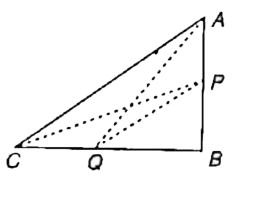Bisectors of angles A, B and C of a triangle ABC intersect its circumcircle at D, E andF respectively. Prove that the angles of the triangle DEF are ,and
We see that
In
But (Angle addition property)
Now,
(.Angles inscribed in the same arc)
[Since is bisector of and is bisector ]
Similarly,
and
Now,
(Angle sum property of triangle)
Similarly,
and
Substituting eq in eq , we get
Similarly,
and
Hence proved.
Topper's Solved these Questions
Similar Questions
Bisectors of angles A, B and C of a triangle ABC intersect its circumcircle at D, E and F respectively. Prove that the angles of the triangle DEF are 90∘−12A,90∘−12Band 90∘−12C
View SolutionThe bisectors of the angles B and C of a triangle ABC , meet the opposite sides in D and E respectively. If DE||BC , prove that the triangle is isosceles.
View Solution
Knowledge Check
Internal bisectors of ΔABC meet the circumcircle at point D, E, and F
Ratio of area of triangle ABC and triangle DEF isA≥1B≤1C≥1/2D≤1/2If the angles of a triangle ABC are in the ratio 2:3:1 then the angles A,B and C are
A∠A=60∘,an≥lB=90∘∘,∠C=30∘B∠A=40∘,an≥lB=120∘∘,∠C=20∘C∠A=20∘,an≥lB=60∘∘,∠C=60∘D∠A=45∘,an≥lB=90∘∘,∠C=45∘If angle C of triangle ABC is 900, then prove that tanA+tanB=c2ab (where, a,b,c, are sides opposite to angles A,B,C, respectively).
Aa2bcBb2caCc2abDa+b
The circumcentre of the triangle ABC is O . Prove that ∠OBC+∠BAC=90∘.
View SolutionIn ΔABC, the internal bisects BD, CD of angle ABC, angle ACB respectively meet at D.show that angle BDC=90∘+A2
View SolutionIn triangle ABC,the bisector of interior angle A and the bisector angle C meet at point O. Prove that ∠AOC=12∠B
View SolutionIn right angled ΔABC,∠B=90∘, if P and Q are points on the sides AB and BC respectively, then :

View SolutionA triangle ABC is such that sin(2A+B)=12. If A,B,C are in A.P. then the angle A,B,C are respectively
View Solution
